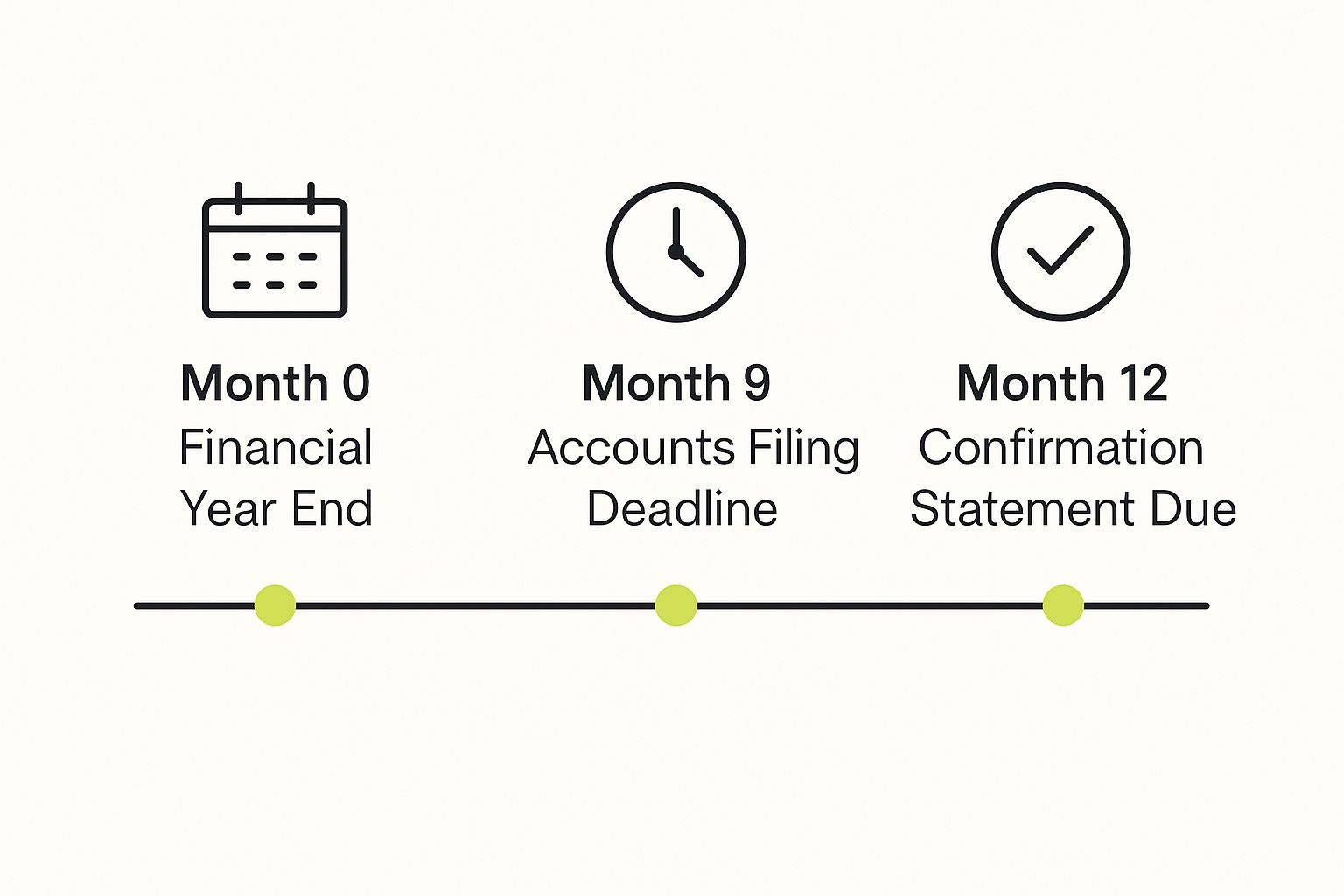
Filing accounts for a dormant company is surprisingly straightforward. It's really just a case of sending a basic balance sheet to Companies House, confirming that no significant business has taken place. But it’s a legal duty you can't skip, even if your company hasn't traded a penny. It’s what keeps you compliant.
The real key is making sure you actually are dormant in the eyes of the law. Let's break down exactly what that means.

Before you even think about filing, you need to be certain your company qualifies as dormant according to Companies House. Their official definition hangs on one critical phrase: having ‘no significant accounting transactions’ during the financial year.
So, what does that actually mean in the real world? It's less complicated than it sounds. A "significant transaction" is basically any financial activity related to trade. Think buying stock, paying a supplier, or invoicing a client. If money is moving in or out of the business for commercial reasons, you're not dormant.
Luckily, a few specific financial movements are allowed without waking your company up. Companies House doesn't consider these 'significant' because they're purely administrative.
You’re in the clear if the only transactions are:
These are simply the costs of keeping the company on the register and don’t count as trading.
On the other hand, some activities will instantly flip your company's status back to 'active', meaning you'll have to file full, detailed accounts. For instance, selling a service, buying a business asset (like a laptop or van), or paying director salaries immediately breaks dormancy.
Even something as small as receiving bank interest can cause headaches, particularly with HMRC.
A crucial point to remember is that Companies House and HMRC play by different rulebooks. While Companies House might not fuss over a few quid of bank interest, HMRC definitely sees it as income. That means you could have a Corporation Tax bill on your hands.
This table gives you a quick reference for what’s allowed and what’s not when it comes to keeping your company dormant for Companies House.
Understanding this distinction is vital for all UK limited companies to sidestep any unexpected tax demands. Even though it's inactive, a dormant company must still file these simplified annual accounts to stay on the right side of the law.
Filing accounts for a dormant company means you're dealing with two different government bodies: Companies House and HMRC. And here’s where a lot of people trip up. It’s a costly mistake to assume that because your company is dormant for Companies House, it's automatically dormant for HMRC too. It’s simply not true, and that oversight can lead to some nasty surprises from the taxman.
The two organisations have completely different ideas about what "dormant" means. Companies House is a bit more flexible—they'll let you make small transactions like paying your filing fees. But HMRC? They're far stricter. For them, a company is only dormant if it has zero income or trading activity. None.
Let’s walk through a classic real-world scenario. Imagine your dormant limited company has a business bank account. It’s just sitting there, but over the year, it earns a tiny £10 in interest.
This single point of difference is where so many directors get caught out. Ticking the box for Companies House is only half the job. You have to manage your relationship with HMRC separately to stay out of trouble.
So, what do you do? If your company is genuinely dormant by HMRC's strict standards—meaning absolutely no income of any kind—your main job is to tell them. You don't have to file a tax return, but you do need to be proactive and let them know your company is dormant for Corporation Tax purposes.
You can get in touch with HMRC’s Corporation Tax office directly. You’ll need your company’s 10-digit Unique Taxpayer Reference (UTR). Once they’ve officially noted your company's dormant status, they'll usually stop sending you notices to file a Company Tax Return. It’s a simple step, but it keeps your records straight and stops any headaches from developing down the line. Keep in mind this is completely separate from the digital tax rules for individuals, which you can read about in our guide on Making Tax Digital for Self Assessment.
This split between the two government bodies is a classic quirk of UK compliance. You can find more detail on HMRC's stricter definition on anna.money.

Alright, you’ve double-checked that your company is dormant in the eyes of both Companies House and HMRC. Now for the easy part.
Filing accounts for a dormant company is one of the most straightforward tasks you'll handle as a director, and most people manage it just fine without an accountant. First things first, you'll need a couple of details to hand.
Before you start, make sure you have:
Don't panic if you can't find the authentication code. It happens. You can easily request a new one from the Companies House website. They'll post it out to your registered office, and it usually lands on your doormat within five working days.
When it comes to submitting your dormant accounts, you have two options. One is quick and modern; the other is… well, a bit old-fashioned.
1. Online via the WebFiling Service
This is the route Companies House prefers, and for good reason. It’s fast, completely free, and you get an instant email receipt confirming they've got your submission. The online forms walk you through each step, which massively cuts down the risk of making a mistake.
2. By Post using Form AA02 (DCA)
You can still go the traditional paper route by downloading and printing Form AA02, the 'Dormant Company Accounts' form. While it gets the job done, it's slower, and you're at the mercy of the postal service. There's always that nagging worry it might get lost or rejected due to a simple error.
Honestly, for speed and peace of mind, the WebFiling service is a no-brainer. It virtually eliminates the chance of missing your deadline and gives you immediate proof that you’ve ticked this legal box for another year.
The main event of your filing is a super-simplified balance sheet. If your company has been dormant since the day it was created, this is incredibly simple.
The form will ask for figures for the current and previous financial years. In most cases, the only thing to report is the value of the shares issued when you set up the company.
For example, if you incorporated with one ordinary share worth £1, your balance sheet would simply show:
You’ll also need to sign a director's statement confirming the company was dormant for the entire accounting period.
Even though the filing itself is simple, keeping all your company's records in order is vital. If you need broader support with your annual reporting, you can learn more about our professional accounts services.
Missing your filing deadline with Companies House is an expensive and easily avoidable mistake. It triggers automatic, legally-enforceable penalties that escalate quickly, even if your company hasn't earned a single penny. Getting your head around the key dates is essential for keeping your dormant company compliant and penalty-free.
If you've just set up your company, you get a bit of extra breathing room. The deadline for your first set of accounts is 21 months from the date of incorporation. This generous initial period gives you plenty of time to get organised. After that first filing, though, it becomes a regular annual task.
For all subsequent years, your dormant accounts are due 9 months after your company's Accounting Reference Date (ARD)—this is essentially your financial year-end.
This timeline lays out the key annual deadlines every dormant company director should have burned into their calendar.

As you can see, the nine-month window is a hard deadline for your accounts. This is a separate duty from the confirmation statement, which needs to be filed within twelve months of the last one.
Companies House doesn't mess around when it comes to late submissions. The penalty system is tiered, and it bites harder the longer you leave it:
What’s worse is that these fines double if you file late for two consecutive years. It’s crucial to remember these dates apply even if you have no tax to pay. If you're unsure about your tax obligations, our guide clarifies what Corporation Tax is and how it all works.
The responsibility for timely filing rests squarely on the company directors. Pleading ignorance of the deadline won’t work as an excuse, making proactive calendar management a non-negotiable part of your role.

It might feel like extra paperwork for no reason, but holding onto a dormant company is often a shrewd, forward-thinking move. The minimal effort of filing accounts for a dormant company once a year can pay off massively in the long run.
One of the biggest drivers is brand protection. Let’s say you’ve got a killer idea for a business but aren't quite ready to launch. By setting up a company with that name and keeping it dormant, you legally ring-fence it. Nobody else can register that name, giving you breathing room to plan your next steps.
A dormant company can also act as a placeholder for a future venture or hold a valuable asset, like a domain name or intellectual property. This approach is especially common for businesses setting up special purpose vehicles for specific, ring-fenced projects.
The real beauty of it? When the time is right, you can flip the switch and start trading instantly. There are no delays waiting for incorporation, allowing you to jump on opportunities the moment they appear. It turns a simple compliance task into a powerful strategic advantage.
This strategy is well-established in the UK. The initial filing deadline of 21 months after incorporation encourages entrepreneurs to secure their company structure early, well before any money changes hands. And because the filing process is so straightforward—often just a simple two-page form—it's an incredibly practical way to gear up for future growth.
Even when the process seems straightforward, a few questions always pop up, especially for directors filing dormant accounts for the first time. Let's tackle the most common ones to clear up any lingering doubts.
If your company has been dormant from the day it was incorporated, the filing process is about as simple as it gets. You’ll still need to submit dormant accounts to Companies House, but your balance sheet will be incredibly basic.
Most of the time, it will only show the value of the shares issued when you set the company up. For example, if you registered with a single £1 share, that's the only figure you’ll need to report. The crucial thing to remember is you must still file these accounts by the official deadline. For your first set of accounts, that's 21 months from your incorporation date.
For a truly dormant company, especially one that has never traded, you probably don’t need an accountant. The Companies House WebFiling service is designed to be user-friendly and walks you through the handful of details required. Most directors can get this done themselves in just a few minutes.
However, if your company was trading before it became dormant, or if it has a slightly more complicated balance sheet from past activities, getting an accountant to handle the first dormant filing can offer some valuable peace of mind. They'll make sure everything is correctly zeroed out and that the submission is spot-on.
A classic mistake is thinking that filing with Companies House is the end of the story. Don't forget to tell HMRC separately that your company is dormant for Corporation Tax. If you don't, they'll keep expecting you to file a tax return.
Once that confirmation email from Companies House lands in your inbox, your dormant accounts are officially filed for the year. That's the main job done.
But don’t pack up just yet. You still have another annual duty: the confirmation statement. This is a totally separate filing that simply confirms all the company's details (like the registered office address and director information) are still correct. Your financial year duties are only truly complete once both filings have been accepted.
Navigating these requirements is all part of running a company, but you don't have to figure it all out alone. GenTax Accountants can make sure all your filings are handled correctly and on time, giving you complete confidence. Find out how we can help at https://www.gentax.uk.